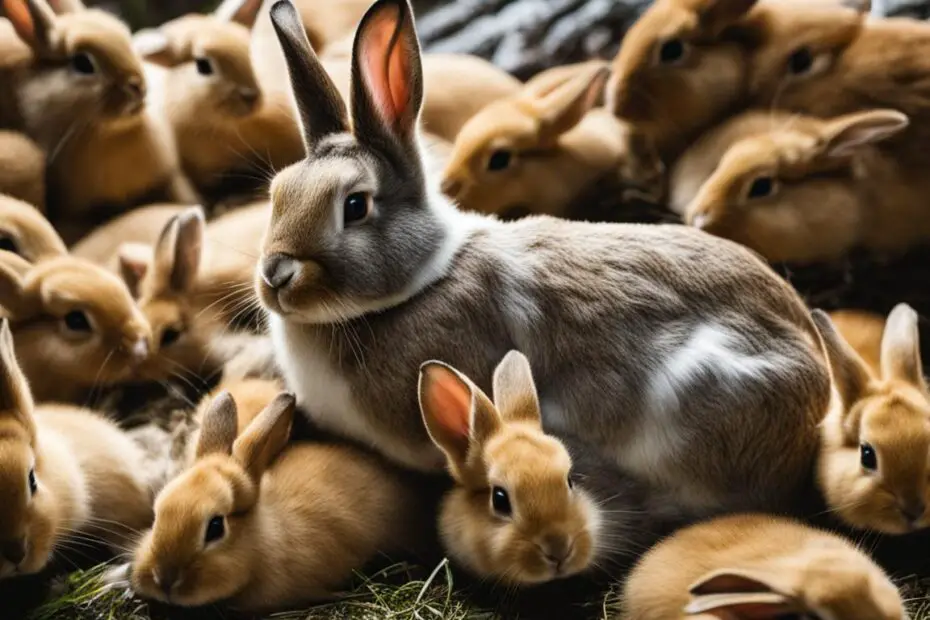Welcome to our comprehensive guide on rabbit labor complications. In this article, we will explore the causes, symptoms, diagnosis, and treatment of rabbit labor complications, commonly known as dystocia. Dystocia refers to the difficulties and complications that can arise during the labor and delivery process in rabbits, which can pose risks to both the mother and the kits.
It is crucial for rabbit owners to understand the signs of labor complications and take appropriate actions to ensure the well-being of their rabbits. Whether you are a new rabbit owner or have been caring for rabbits for years, this guide will provide you with valuable information to navigate through rabbit labor complications effectively.
Key Takeaways:
- Rabbit labor complications, also known as dystocia, refer to difficulties during the labor and delivery process in rabbits.
- Causes of rabbit labor complications include maternal and fetal factors such as abnormalities, malnutrition, and oversize.
- Common symptoms of rabbit labor complications include persistent contractions, inappetence, swollen vulva, and bloody discharge.
- Prompt veterinary intervention is necessary to diagnose and treat rabbit labor complications.
- Providing proper care during rabbit pregnancy is essential to minimize the risks of labor complications.
Causes of Rabbit Labor Complications
Rabbit labor complications can occur due to various factors, both maternal and fetal. Maternal factors include pelvic, vaginal, or uterine abnormalities, malnutrition, obesity, or hereditary conditions. These conditions can affect the doe’s ability to expel the fetus(es) from the uterus during labor. Additionally, fetal causes such as malposition, malpresentation, fetal death, or oversize can also contribute to labor complications in rabbits.
Another cause of rabbit labor complications is uterine inertia, which can be either primary or secondary. Primary uterine inertia is when the doe fails to progress into stage 2 labor, while secondary uterine inertia occurs when the doe is unable to expel an obstructed fetus. Uterine inertia can be a result of hormonal imbalances, infection, dehydration, or stress.
It is important to understand and identify the potential causes of rabbit labor complications in order to provide appropriate care and intervention to ensure the health and well-being of the mother and the kits.
Rabbit Labor Complications: Common Causes
| Maternal Factors | Fetal Factors | Uterine Inertia |
|---|---|---|
| Pelvic, vaginal, or uterine abnormalities | Malposition, malpresentation, fetal death, oversize | Primary or secondary uterine inertia |
| Malnutrition | Hormonal imbalances | |
| Obesity | Infection | |
| Hereditary conditions | Dehydration | |
| Stress |
Table: Overview of common causes of rabbit labor complications. Maternal factors include pelvic, vaginal, or uterine abnormalities, malnutrition, obesity, or hereditary conditions. Fetal factors can include malposition, malpresentation, fetal death, or oversize. Uterine inertia can be either primary or secondary and can result from hormonal imbalances, infection, dehydration, or stress.
Symptoms of Rabbit Labor Complications
The process of rabbit labor can sometimes present various challenges and complications. It is important for rabbit owners to be aware of the symptoms that may indicate labor difficulties or birthing complications. By recognizing these signs, prompt veterinary care can be sought to ensure the health and well-being of both the mother rabbit and her kits.
Common Symptoms
Some common symptoms of rabbit labor complications include:
- Weakness and lethargy
- Anorexia or loss of appetite
- Difficulty breathing
- Abnormal behavior
In severe cases, there may be stillbirth or sudden death of the mother rabbit or her kits. It is crucial to closely monitor the pregnant doe and seek immediate veterinary assistance if any abnormal symptoms are observed.
“It is important for rabbit owners to closely observe their pregnant does during the labor process. Any signs of distress or abnormal behavior should be taken seriously and veterinary care should be sought. Prompt intervention can greatly improve the chances of a successful delivery and the health of the mother and her kits.” – Dr. Karen Johnson, Veterinarian
Visual Representation – Symptoms of Rabbit Labor Complications
| Symptoms | Description |
|---|---|
| Weakness and lethargy | The doe may appear weak, lack energy, and may not move around much. |
| Anorexia or loss of appetite | The doe may refuse to eat or show a decreased interest in food. |
| Difficulty breathing | Labored breathing or rapid, shallow breaths may be observed. |
| Abnormal behavior | The doe may exhibit restless behavior, such as excessive nesting or digging. |
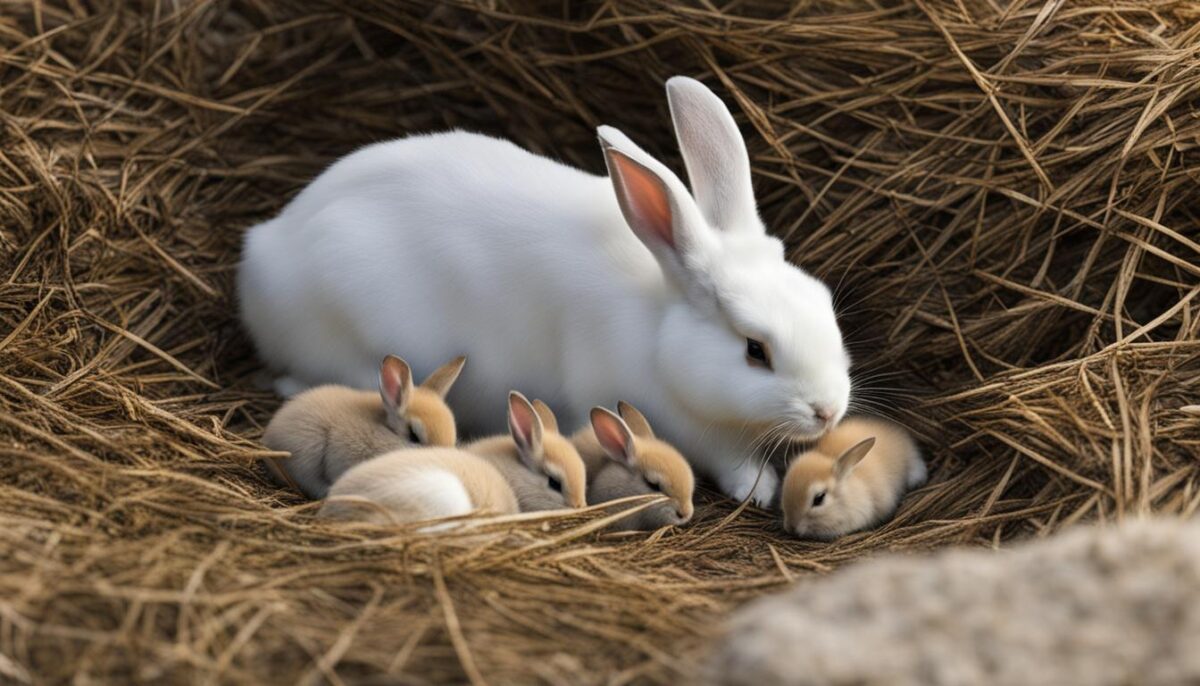
Diagnosis and Treatment of Rabbit Labor Complications
When a rabbit experiences labor complications, prompt diagnosis and treatment are crucial to ensure the health and well-being of both the mother and her kits. A veterinarian can diagnose rabbit labor complications based on clinical signs, physical examination, and medical history. In some cases, additional tests such as blood or urine analysis may be performed to confirm the diagnosis and identify any underlying causes.
Once the diagnosis is confirmed, treatment options can be implemented. The specific treatment plan will depend on the severity and underlying cause of the labor complication. In less severe cases, manual extraction of the fetus may be necessary to assist the doe in delivering her kits. Medications such as oxytocin or calcium may also be administered to stimulate contractions and facilitate the birthing process.
In more severe cases of rabbit labor complications, a Caesarean section may be required. This surgical procedure involves making an incision in the doe’s abdomen to remove the obstructed fetus(es). Caesarean sections should only be performed by a skilled veterinarian and under appropriate anesthesia.
| Diagnosis | Treatment |
|---|---|
| Based on clinical signs, physical examination, and medical history | Manual extraction of fetus(es) |
| Additional tests like blood or urine analysis may be performed | Medications (e.g., oxytocin, calcium) |
| – | Caesarean section (in severe cases) |
In all cases, it is essential to closely monitor the doe during and after treatment to ensure proper recovery. Post-treatment care may include providing a clean and comfortable environment, ensuring the doe has access to nutritious food and water, and administering any prescribed medications. Regular veterinary check-ups can help monitor the doe’s progress and address any potential complications that may arise.
By promptly diagnosing rabbit labor complications and implementing appropriate treatment, the chances of a successful outcome for both the mother and her kits can be significantly improved. Owners should work closely with their veterinarians to ensure the best possible care for their rabbits during labor and delivery.
Rabbit Pregnancy and Gestation Period
Understanding the duration of rabbit pregnancy and the gestation period is crucial for rabbit owners to provide proper care and support to their pregnant does. The gestation period of rabbits typically ranges from 29 to 35 days, with an average duration of 30 to 32 days. Female rabbits, also known as does, can become pregnant as early as 12 weeks of age and continue to have babies until they are four years old.
Rabbits have a unique reproductive ability as they can conceive at any time of the year. Unlike many other animals that have specific mating seasons, rabbits are known for their continuous breeding capability throughout the year. This adaptability allows them to reproduce and expand their population rapidly. However, it is important to be aware of your rabbit’s pregnancy status and provide appropriate care and nutrition during this time to ensure the well-being of both the mother and the kits.
During pregnancy, the doe’s nutritional needs increase, and it is advisable to provide a balanced diet that includes dark leafy greens, alfalfa hay, and rabbit pellets. It is essential to monitor the doe’s appetite and ensure she is receiving adequate nutrition to support the growth and development of the kits. Additionally, providing a comfortable and secluded space for the doe to give birth is important to minimize stress and create a safe environment for the kits.
Signs of Rabbit Pregnancy
Recognizing the signs of rabbit pregnancy is important for rabbit owners to provide appropriate care and support to their pregnant does. One of the common signs is nesting behavior, where the doe starts building a nest using hay or straw. She may also pull out her fur to line the nest and create a warm environment for her kits. This instinctive behavior typically occurs a few days before giving birth.
Additionally, pregnant rabbits may display changes in behavior. Some rabbits become more territorial and protective of their space, while others may show aggression towards other rabbits or humans. These behavioral changes are a result of hormonal fluctuations during pregnancy and should be monitored closely to ensure the safety of both the doe and the caretakers.
Another sign of rabbit pregnancy is weight gain. As the gestation period progresses, pregnant does will start to gain weight due to the growth of the kits inside their womb. Caretakers should keep an eye on the doe’s weight and adjust her diet accordingly to ensure she receives the necessary nutrients for a healthy pregnancy.
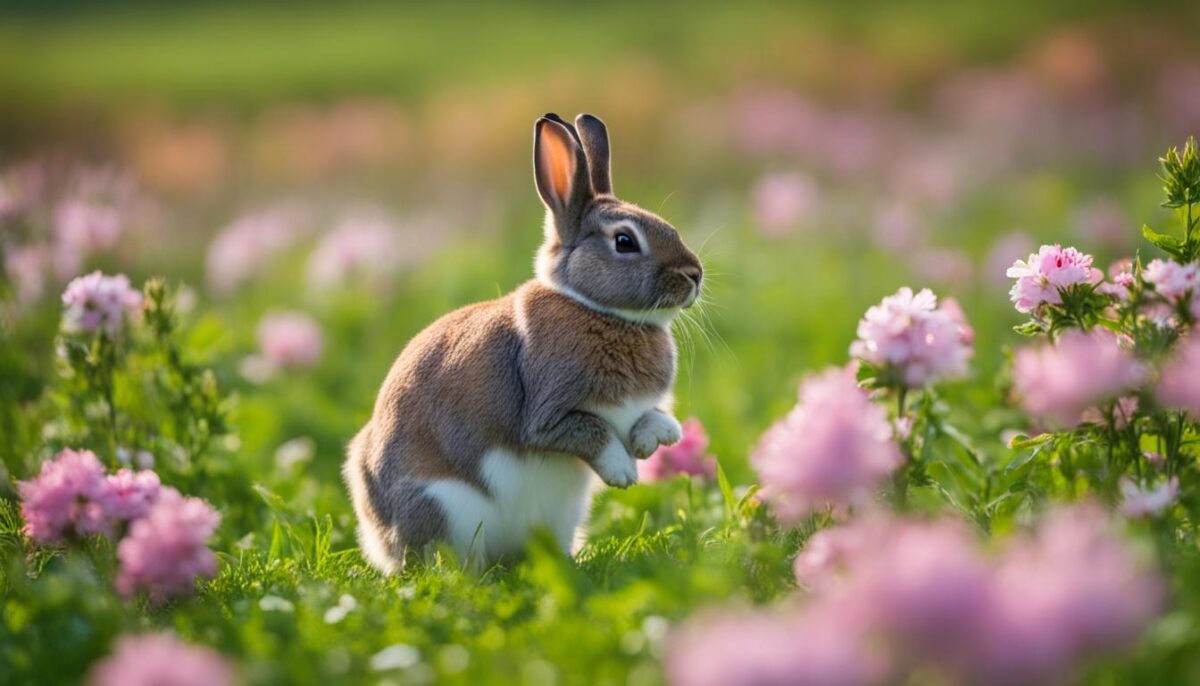
A nutritious diet is essential during rabbit pregnancy to support the developing kits. Dark leafy greens such as kale, spinach, and romaine lettuce provide essential vitamins and minerals. Alfalfa hay is a good source of calcium, which is important for the doe’s skeletal health and the kits’ development. Rabbit pellets specially formulated for pregnant and nursing does can provide additional nutrients.
Creating a cozy and quiet nest box for the pregnant doe is crucial. Line the box with soft bedding material such as straw or hay. This will provide comfort for the doe and a warm environment for the newborn kits. Ensure that the nest box is placed in a quiet and undisturbed area to minimize stress. Regular monitoring of the doe’s behavior and nesting activity is important to anticipate the timing of labor and be prepared for the birthing process.
Key Points:
- Provide a nutritious diet consisting of dark leafy greens, alfalfa hay, and rabbit pellets.
- Ensure the pregnant doe has access to clean water at all times.
- Create a cozy and quiet nest box for the doe to give birth.
- Monitor the doe’s behavior and nesting activity for signs of impending labor.
By providing proper care during rabbit pregnancy, you can help ensure a healthy and successful birthing process for the mother and the kits. Consult with a veterinarian for specific dietary recommendations and any concerns or questions you may have.
Rabbit Birth and Litter Size
When a doe gives birth, it is called kindling. The kindling process typically takes around 15 minutes and usually occurs in the early hours of the morning. During this time, the doe may appear restless and exhibit nesting behavior, creating a comfortable nest for her upcoming litter. It is important to provide a quiet and secluded space for the doe to give birth, as this helps minimize stress and promote a safe environment.
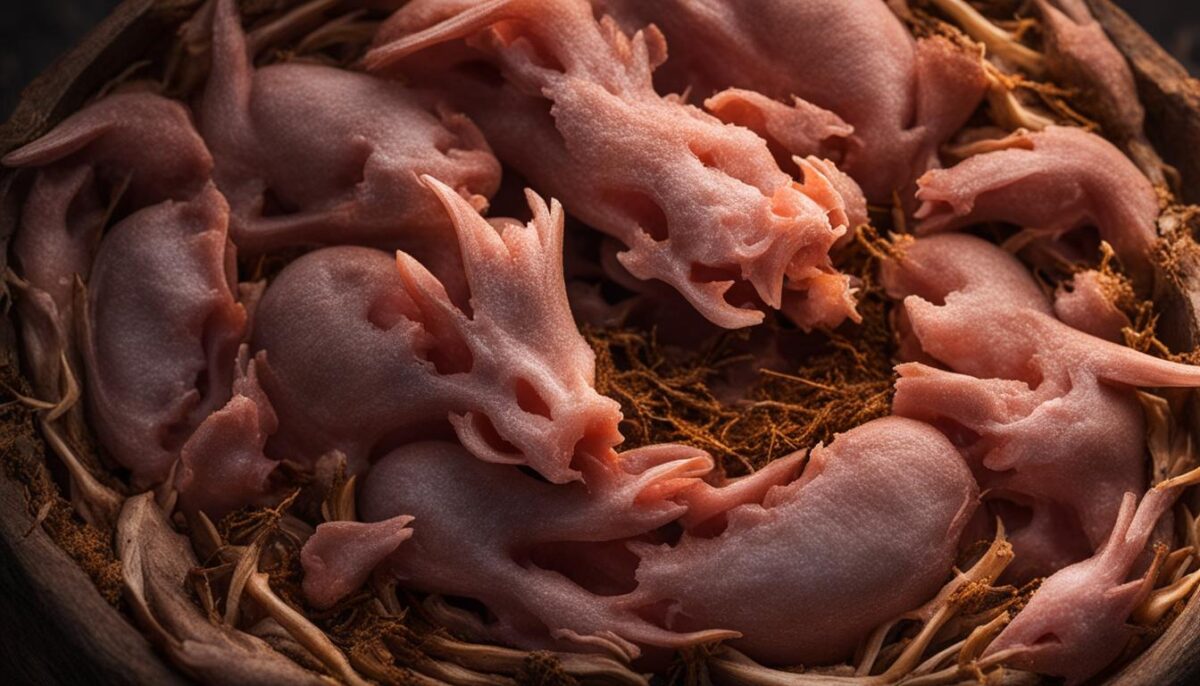
Once the kindling process is complete, the doe will begin nursing her kits. Baby rabbits, known as kits, are born hairless, blind, and deaf. They rely on their mother’s milk for sustenance and will nurse approximately twice a day. It is important to monitor the kits’ growth and development, ensuring they are gaining weight and exhibiting normal behavior.
The litter size in rabbits can vary, with an average of six kits per litter. However, some litters can have as few as one or as many as 14 kits. Multiple factors can influence litter size, including the age and health of the doe. Providing proper nutrition and a stress-free environment during pregnancy can increase the likelihood of a larger litter. It is essential to handle newborn kits with care and avoid disturbing the nest unnecessarily, as this can cause stress to the mother and potentially harm the kits.
Overall, understanding the kindling process and the variability in litter size is important for rabbit owners. By providing appropriate care and monitoring the health of both the mother and the kits, owners can ensure a successful and rewarding birthing experience.
Rehoming Kits and Postpartum Care
Once the kits are around eight weeks old, they can be weaned and are ready to leave their mother. It is essential to find suitable homes for them, ensuring that the new owners have the proper accommodations and knowledge to care for rabbits. Rehoming the kits responsibly is crucial for their well-being and long-term happiness.
To ensure the mother rabbit’s health, she should receive postpartum care. This includes providing her with a clean and comfortable environment, nutritious food, and regular veterinary check-ups. The mother rabbit may need extra care and attention after giving birth, as she has gone through the physically demanding process of labor. Monitoring her closely and addressing any postpartum complications promptly will help ensure her full recovery.
Proper postpartum care also includes preventing re-impregnation soon after giving birth. Female rabbits should be kept separate from males to avoid any unwanted pregnancies. It takes time for the mother rabbit’s body to recover fully, and allowing her some rest and space before considering further breeding is essential.
Remember, rabbits are social animals, and they value companionship. Separating the mother from her kits will be a significant change for her. Providing her with companionship, such as a compatible rabbit or extra human interaction, can help alleviate any potential stress or loneliness she may experience.
Table: Recommended Postpartum Care for Mother Rabbit
Below is a table summarizing the essential aspects of postpartum care for mother rabbits:
| Care Aspect | Recommendations |
|---|---|
| Environment | Provide a clean and comfortable living space for the mother rabbit. |
| Nutrition | Offer a balanced diet that includes fresh hay, vegetables, and a limited amount of pellets. |
| Veterinary Check-ups | Schedule regular check-ups to monitor the mother’s health and address any postpartum complications. |
| Companionship | Provide social interaction and companionship to the mother rabbit to prevent loneliness. |
By following these guidelines and providing the necessary care, you can ensure the well-being of both the kits and the mother rabbit after the birthing process. Remember to be patient and observant, as each rabbit may have different postpartum needs. With proper care and attention, your rabbits can thrive and have a healthy start in life.
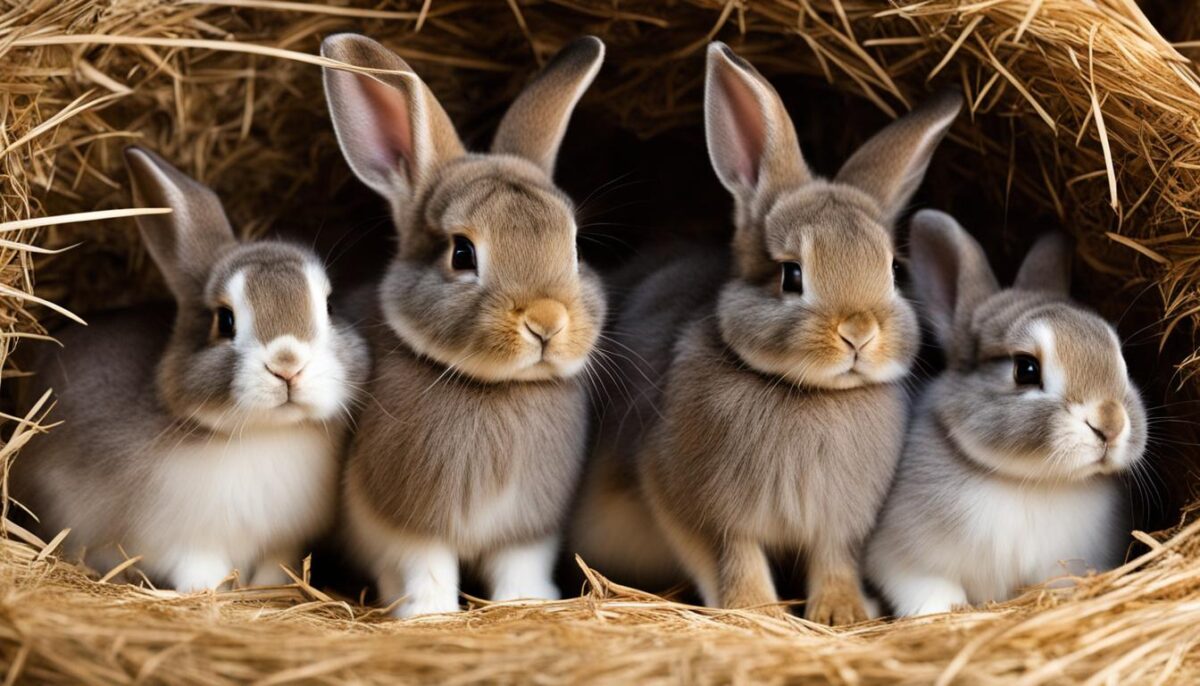
Conclusion
Understanding rabbit labor complications is crucial for responsible rabbit owners. By familiarizing themselves with the causes, symptoms, and proper care during pregnancy and labor, owners can take preventive measures to minimize the risks of complications. Regular veterinary check-ups, a balanced diet, and a stress-free environment are key factors in ensuring a safe and successful birthing process for rabbits.
With knowledge of the common causes of rabbit labor complications, such as maternal and fetal factors, owners can monitor their rabbits for any warning signs and seek prompt veterinary intervention if necessary. Early diagnosis and timely treatment can greatly improve the chances of a positive outcome for both the mother and the kits.
In addition to proactive steps during pregnancy and labor, postpartum care plays a vital role in the well-being of the mother rabbit and the kits. A clean and comfortable environment, nutritious food, and regular veterinary check-ups are essential for a healthy recovery. Female rabbits should also be kept separate from males to prevent re-impregnation immediately after giving birth.
By following these guidelines and prioritizing the welfare of their rabbits, owners can ensure a smooth and safe birthing process, preventing or minimizing the occurrence of rabbit labor complications. Responsible ownership and proactive care are the foundations of a healthy rabbit breeding program.
FAQ
What is dystocia in rabbits?
Dystocia in rabbits refers to complications during the labor and delivery process, where the doe is unable to expel the fetus(es) from the uterus.
What are the symptoms of dystocia in rabbits?
Symptoms of dystocia in rabbits include persistent contractions, inappetence, swollen vulva, and bloody discharge.
What causes rabbit labor complications?
Rabbit labor complications can be caused by maternal factors such as pelvic abnormalities, malnutrition, or uterine conditions, as well as fetal factors like malposition, fetal death, or oversize.
How can rabbit labor complications be diagnosed?
A veterinarian can diagnose rabbit labor complications based on clinical signs, physical examination, and medical history. Additional tests may be performed to confirm the diagnosis.
What are the treatment options for rabbit labor complications?
Treatment options may include manual extraction of the fetus, administration of medications, and supportive care. In severe cases, a Caesarean section may be necessary.
How long is the gestation period for rabbits?
The gestation period for rabbits typically ranges from 29 to 35 days, with an average of 30 to 32 days.
What are the signs of rabbit pregnancy?
Signs of rabbit pregnancy include nest building behavior, aggressive behavior, and increased protectiveness of their space.
How should I care for a pregnant rabbit?
Provide a nutritious diet, access to clean water, and a comfortable and secluded space for the doe to give birth.
How many kits can a rabbit have in a litter?
The litter size can vary, with an average of six kits per litter, although some litters can have up to 14 kits.
When can kits be weaned and separated from their mother?
Kits can be weaned and ready to leave their mother at around eight weeks of age.
What should be done for the mother rabbit after giving birth?
The mother rabbit should be provided with a clean and comfortable environment, nutritious food, and regular veterinary check-ups.


